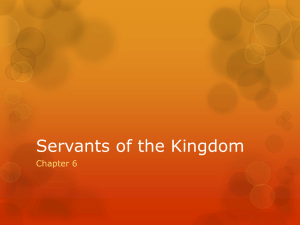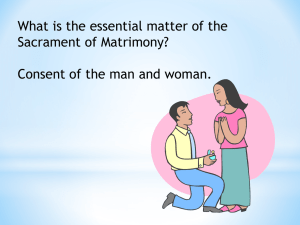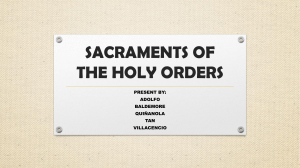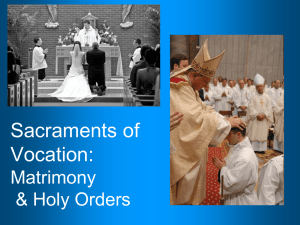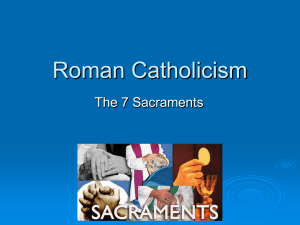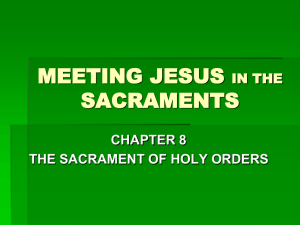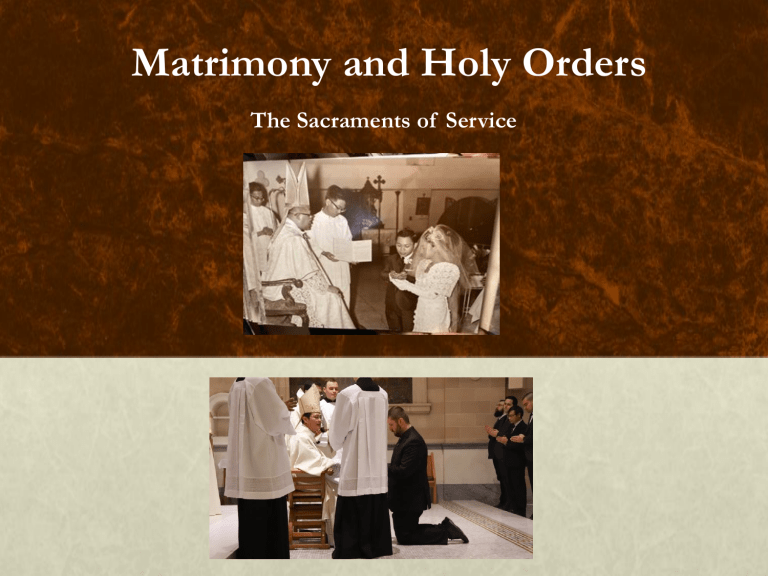
Matrimony and Holy Orders The Sacraments of Service 1. The Sacrament of Matrimony BASIC QUESTIONS What is the Sacrament of Matrimony? What does it mean to say Matrimony is a vocation? How does the Sacrament of Matrimony relate to natural marriage? KEY IDEAS Matrimony, a Sacrament at the Service of Communion, is a vocation to a state of life that joins a baptized man and woman in a lifelong covenant of love for the good of the spouses and the procreation and education of children. Instituting the Sacrament of Matrimony, Christ restored natural marriage to its original intention at creation and endowed it with graces that make it possible to live its true meaning. 1. The Sacrament of Matrimony According to Pope Benedict XVI what is the vocation of the family? The vocation of the family is to accompany each other on the path of the discovery of God and of the plan that he has prepared for each of its members. How did the Blessed Virgin Mary and St. Joseph help Christ along the path that God the Father had prepared for him? By their example, they showed him the beauty of faith, the love of God and his Law, the demands of justice, and how to do God’s will. 1. The Sacrament of Matrimony Why is Matrimony a state in life? Matrimony is a permanent way of living. Who can receive this Sacrament? Ordinarily only baptized persons can receive Matrimony, although there are exceptions. How long does Christian marriage last? The Sacrament of Matrimony lasts as long as both spouses are alive. What kind of agreement is a sacramental marriage? A sacramental marriage is a covenant, that is, a solemn agreement between the spouses and God. It is a covenant of love: that is, love is its essential dimension. Extension: Covenants in the Old Testament invoked blessings for faithfulness and curses for unfaithfulness. What are the two purposes of this Sacrament? The two purposes of Matrimony are (1) the good of the spouses, and (2) the procreation and education of children. Why is Matrimony a Sacrament at the Service of Communion? It brings a husband and a wife together in mutual aid and in service of each other first, and secondly to their children. It also serves the Church by being a kind of reflection of what God’s love is like. 1. The Sacrament of Matrimony Why is the married state in life called a vocation? It is a call from God to each of the spouses to enter into a way of living that joins them together in a lifelong covenant of love for their mutual good and the procreation and education of children. Is marriage a human invention? No; marriage is written in the very nature of man and woman as they come from the hand of the Creator. We can see in Genesis that God said it was not good for man to be alone. Jesus also talks of the nature of marriage during His ministry. Marriage dates to the creation of human beings. God created man and woman in the state of marriage. They were in perfect union with God and with each other. How is marriage an image of God? Marriage is the communion of man and woman. This relationship of man and woman is an image of God, who is a communion of three divine Persons in the Blessed Trinity. How did Adam and Eve’s mutual relationship change after the Fall? In consequence of the Fall, Adam and Eve’s union of love was marred by mutual blame. Their natural attraction often degenerated into domination and lust. Their vocation to be fruitful, multiply, and subdue the earth was saddled by pain in childbirth and toil in work. The union and love got corrupted and gets manifested in wrong ways after the fall. An example of this deterioration of what was the original union can be seen in the Mosaic Law, which tolerated polygamy at first and divorce and required that a widow marry her husband’s brother if he died without an heir. Jesus says this was so because their hearts were so hardened. Matt 19:8 “He said to them, “It was because you were so hard-hearted that Moses allowed you to divorce your wives, but from the beginning it was not so.” 1. The Sacrament of Matrimony What was the positive dimension of the Mosaic Law toward marriage (cf. CCC 1610)? The Mosaic Law protected the wife from arbitrary domination by her husband. Moses allowed men to divorce their wives because of their “hardness of heart.” What positive vision of marriage did the prophets introduce? The prophets described marriage between a man and a woman as a reflection of God’s covenant relationship with his people, Israel, an image of exclusive and faithful married love. CCC 1610 “In the Old Testament the polygamy of patriarchs and kings is not yet explicitly rejected. Nevertheless, the law given to Moses aims at protecting the wife.” 1. The Sacrament of Matrimony The significance the Church sees in this wedding feast miracle Christ performed his first miracle at the Wedding at Cana, where he changed water into wine. The Church views this miracle as “the confirmation of the goodness of marriage and the proclamation that thenceforth marriage will be an efficacious sign of Christ’s presence” (CCC 1613). Mark 10:6-9 affirms that marriage is of Divine origin, Christ gave marriage an elevated meaning from what was happening in Jewish custom and Christ emphasized the nature of marriage as a lifelong covenant and vocation. 6 But from the beginning of creation, ‘God made them male and female.’ 7 ‘For this reason a man shall leave his father and mother and be joined to his wife, 8 and the two shall become one flesh.’ So they are no longer two, but one flesh. 9 Therefore what God has joined together, let no one separate.” 1. The Sacrament of Matrimony Why did Christ elevate Matrimony to a Sacrament? Christ elevated Matrimony to a Sacrament to make special graces available to married couples so that they can live as he wants them to live. Graces were lost after the fall, so natural marriage was not enough to get two spouses through the crucible of life. What does it mean to say that Christ “elevated” Matrimony? Christ took something that already existed (natural marriage), restored it to its original meaning from before the Fall, and provided the graces necessary for that sacramental meaning to be lived out by the spouses. This original meaning was expressed in the words of Genesis, “The two will become one flesh,” ruling out polygamy, divorce, domination, selfishness, and the like. 1. The Sacrament of Matrimony FOCUS QUESTIONS Why do spouses need the sacramental graces of the Sacrament of Marriage? Spouses need to overcome Original Sin and their own actual sins, which can destroy their union. Their union creates the domestic church. What effects can rejection of God have on a marriage? Rejection of God can make a marriage degenerate into discord and jealousy because the spouses can more easily be focused on self-interest instead of self-sacrifice. The meaning of marriage gets corrupted, and the broken state of human weakness is accepted as the norm. What is the ultimate aim of the Sacrament of Matrimony? The ultimate aim of Matrimony is the salvation of the spouses and their children. What did St. Paul affirm about marriage? St. Paul affirmed that marriage between Christians is a reflection of Christ’s relationship with his Church. Out of love, Christ sacrificed himself for his Bride, the Church, and a husband must love his wife in the same way. 1. The Sacrament of Matrimony Based on what you have learned so far about Matrimony, why might the Church object to sex outside of marriage? 2. Celebrating Matrimony 1 Corinthians 13:1-13, 13 If I speak in the tongues of mortals and of angels, but do not have love, I am a noisy gong or a clanging cymbal. 2 And if I have prophetic powers, and understand all mysteries and all knowledge, and if I have all faith, so as to remove mountains, but do not have love, I am nothing. 3 If I give away all my possessions, and if I hand over my body so that I may boast, but do not have love, I gain nothing. 4 Love is patient; love is kind; love is not envious or boastful or arrogant 5 or rude. It does not insist on its own way; it is not irritable or resentful; 6 it does not rejoice in wrongdoing, but rejoices in the truth. 7 It bears all things, believes all things, hopes all things, endures all things. 8 Love never ends. But as for prophecies, they will come to an end; as for tongues, they will cease; as for knowledge, it will come to an end. 9 For we know only in part, and we prophesy only in part; 10 but when the complete comes, the partial will come to an end. 11 When I was a child, I spoke like a child, I thought like a child, I reasoned like a child; when I became an adult, I put an end to childish ways. 12 For now we see in a mirror, dimly, but then we will see face to face. Now I know only in part; then I will know fully, even as I have been fully known. 13 And now faith, hope, and love abide, these three; and the greatest of these is love. Because these words are often heard at nuptial Masses, they are sometimes considered romantic and, therefore, easy to live out. However, in fact, are they actually very demanding, requiring self-control, self- sacrifice, generosity, and maturity. 2. Celebrating Matrimony BASIC QUESTIONS What is necessary for the valid reception of the Sacrament of Matrimony? What are the matter, form, and ministers of Matrimony? KEY IDEAS For the valid reception of the Sacrament of Matrimony, each spouse must be of legal age, be free to marry, freely consent, and intend to undertake what the Church understands are the responsibilities of marriage. A marriage must be properly witnessed. The matter, form, and ministers of the Sacrament are the couple themselves and their freely given vows. 2. Celebrating Matrimony FOCUS QUESTION What are the requirements to receive the Sacrament of Matrimony validly? Each spouse must be of legal age of consent; not be married to someone else under civil law; not be in a valid sacramental marriage; freely consent to marry (this means internal and external freedom); intend to marry for life, to be faithful to one another, and to be open to the procreation of children; and give his or her consent before two witnesses and a bishop or priest. 2. Celebrating Matrimony FOCUS QUESTIONS What is a mixed marriage? A mixed marriage is a marriage between a Catholic and a baptized Christian not in union with the Catholic Church. What is a marriage of disparity of cult? A marriage of disparity of cult is a marriage between a Catholic and a non-Christian. This may result in religious indifference if the couple does not take their faith seriously. May a Catholic marry a baptized non-Catholic or even a non-Christian? Yes; both situations, however, bring certain difficulties that demand prudence and caution. The faith of the Catholic spouse cannot be put under coercion or strain not to believe, and the raising of children has to be open to the fact of raising them in the Catholic faith. Whose permission should a Catholic obtain to marry a non-Catholic? A Catholic should obtain a dispensation from his or her bishop to marry a non-Catholic. What is the danger the Catholic spouse faces in marrying a non-Catholic? The two spouses are separated in key areas of belief and practice, which could result in disunity and difficulties in rearing their children. 2. Celebrating Matrimony FOCUS QUESTIONS How can marriage to a non-Catholic be of benefit to the non-Catholic spouse? The Catholic spouse consecrates his or her spouse, and this consecration can lead the non-Catholic spouse to convert to the Catholic Faith. With what is a bishop concerned when a Catholic wants to marry a nonCatholic? The bishop is concerned that both parties know and do not exclude from their marriage the essential ends and properties of marriage. He also wants to ensure that the Catholic party confirms the obligations of preserving his or her own faith and of baptizing and educating the children in the Catholic Church and that the non-Catholic party is aware of this commitment. 2. Celebrating Matrimony FOCUS QUESTIONS What is a dispensation from canonical form? It is permission from a bishop to celebrate Matrimony in a place other than a Catholic church. How can a Catholic spouse contribute to the conversion of a non-Catholic spouse? He or she can do so through sincere married love, humble and patient practice of virtues, and perseverance in prayer. What is the matter of the Sacrament of Matrimony? The matter of the Sacrament of Matrimony is the couple itself. What is the form of Matrimony in the Latin Rite of the Catholic Church? The form of Matrimony is the vows that the people exchange. What act seals or consummates the Sacrament of Matrimony? The marriage act (conjugal act) seals the Sacrament of Matrimony. 2. Celebrating Matrimony FOCUS QUESTION What is necessary for the form of Matrimony to be valid? To form a valid matrimonial bond, both the man and woman must consent to a permanent, indissoluble union and to openness to having children. If either person rejects either one of these elements, then there is no sacramental marriage. Who are the ministers of Matrimony in the Western Catholic Church? The ministers are the people marrying each other. What is the role of the bishop, priest, or deacon who presides at a Catholic marriage in the Western Catholic Church? He acts as the official witness of the Church. Why is it fitting to have the Sacrament of Matrimony occur within the context of the Mass? Christian marriage empowers spouses to attain the love that Christ has for his Church, and it is in the Sacrifice of the Mass that Christ’s love for his Church is most manifest. 3. The Effects of the Sacrament of Marriage and Problems in Marriage BASIC QUESTIONS What are the qualities of a valid, sacramental marriage? Can a Catholic divorce? What is an annulment? What are the effects of the Sacrament of Matrimony? KEY IDEAS The Sacrament of Matrimony unites the spouses in a permanent, faithful, and indissoluble union, which is open to procreation and lasts as long as both spouses live. Validly married spouses can separate or even obtain a civil divorce, but they are not free to remarry. An annulment is a judgment by the Church that a valid sacramental marriage never existed due to some condition that rendered the union invalid. The Sacrament of Matrimony endows the spouses with special graces to enable them to love each other with the same self-sacrificing love with which Christ loves his Bride the Church, to live the unity and indissolubility of their marriage, and to uphold the unitive and procreative purposes of the marriage act. 3. The Effects of the Sacrament of Marriage and Problems in Marriage What are the model and means by which Christian spouses perfect and sanctify their love? The model of Christian love is the union of Christ and his Church, and the means by which spouses sanctify their love are the graces with which God endows the Sacrament of Matrimony. What are the two essential properties of Matrimony? They are unity and indissolubility. What are the two purposes or aims of the marital act? They are the unitive and procreative. Extension: The unitive is the expression of the love between the spouses, and the procreative is openness to bringing a new child into the world. Both the Church and natural law indicate that it is immoral to separate these two purposes. That is, spouses must not commit an act, which either renders the marital act infertile (e.g., contraception) or attempts to procreate without the marital act (e.g., in vitro fertilization). 3. The Effects of the Sacrament of Marriage and Problems in Marriage Can a valid and consummated marriage ever be dissolved? No. Why can the Church not grant divorce? The Church does not have the power to abolish the covenant that God establishes between husband and wife. What is a declaration of nullity, or annulment? It is a judgment by the Church, upon careful examination, that a sacramental marriage never took place. For example, if a couple married in the Church and one of the partners secretly intended never to have children, then a valid marriage would never have occurred. Is an annulment a “Catholic divorce”? No; it is a statement that the Church, after a thorough investigation of the facts, has determined that a valid marriage did not exist in the first place and, therefore, the couple’s union was never a sacramental marriage. Can an individual who has received an annulment enter into a valid sacramental marriage? Yes; he or she has never been married. 3. The Effects of the Sacrament of Marriage and Problems in Marriage FOCUS QUESTIONS Can a person who has had a civil divorce receive Holy Communion? Yes, a divorced person can receive the Eucharist on the condition that he or she has not remarried without having received a declaration of nullity. Why can a person who has been validly married, obtained a civil divorce, and entered a second marriage outside the Church not receive the Eucharist? He or she is living in a state of adultery, a mortal sin. Receiving the Eucharist in a state of mortal sin is in itself the mortal sin of sacrilege. What is the Church’s attitude toward divorced and remarried persons? The Church offers them her love, prayers, and support in their difficult situation and encourages them to seek full communion with the Church. 3. The Effects of the Sacrament of Marriage and Problems in Marriage FOCUS QUESTIONS Is marriage a purely private affair between two persons? No; marriage is critical for the good of the individual, the family, the Church, and society in general. For this reason, the original and traditional status of marriage should be upheld and defended by all. What spiritual qualities do conjugal relations demand, according the Church? Conjugal relations must possess the spiritual qualities of permanence, fidelity, and openness to procreation. According to the Catechism, no. 1643, what elements of the human person does conjugal love involve? It involves the total human person and unites spouses physically, emotionally, and spiritually. 3. The Effects of the Sacrament of Marriage and Problems in Marriage FOCUS QUESTIONS How can a person obtain an annulment? He or she can prove some kind of impediment to a sacramental marriage existed at the time the Sacrament of Matrimony was administered. Under what circumstances might separation be appropriate? Separation may be appropriate in situations involving domestic abuse or addiction to alcohol or other drugs. What are some impediments to a valid, sacramental marriage? Impediments include consent based on fear or coercion; serious immaturity; psychological incapacity; and the absence of a proper intention to have children, to be faithful, or to remain together until death. Do grounds for an annulment always show themselves early in the marriage? No; sometimes these issues do not present themselves to the couple until they have been married for some years and even begun to raise children. Are children in a nullified marriage illegitimate? No. 3. The Effects of the Sacrament of Marriage and Problems in Marriage Based on what you have learned about the nature of marriage, why do you think the Church cannot confer the Sacrament of Matrimony on two people of the same sex? The Sacrament of Holy Orders THE SACRAMENTS : Source of our Life in Christ 1. The Priesthood in the Old and New Testaments BASIC QUESTIONS What are the Sacraments of Service? What is the priesthood in Judaism? Did Jesus Christ establish a priesthood for his Church? KEY IDEAS The Sacraments of Service are Holy Orders and Matrimony. In the Old Testament we see that God established a priestly people, the Jews, and a hereditary priesthood in the Tribe of Levi. Jesus Christ established a priesthood for his Church through a personal call to his Apostles. Holy Orders is a sacrament through which men are marked with an indelible character and constituted Sacred ministers-bishops, priests and deacons- to teach, sanctify, and govern the faithful in the person of Christ the Head. 1. The Priesthood in the Old and New Testaments Focus Questions What is a Sacrament of Service? It is a Sacrament that consecrates a person to the service of others. What is a minister? Minister comes from the Latin word that means servant. Who are ordained ministers in the Catholic Church? Bishops, priests, and deacons. What is the service that ordained ministers in the Catholic Church provide? They serve Jesus Christ, who acts in his Church through them, especially through the Sacraments. 1. The Priesthood in the Old and New Testaments Sacrament Holy Orders Matrimony The Sacraments of Service Service it Provides A bishop, priest or deacon is consecrated to serve the Church to bring people to salvation. The spouses are consecrated to serve one another and the children God gives them. Common/Royal Shared by all the baptized Christians by the virtue of the threefold ministry of Christ (priest, prophet and king) Ministerial Those who are in the hierarchy; the deacons, priests and bishops. They are ordained for the service of the common/royal priesthood 1. The Priesthood in the Old and New Testaments How is the priesthood first seen in the Old Testament? In the Old Testament, the entire Hebrew people were priestly, that is, they were to reveal God to the world and to represent mankind before him. In early Israel, the father of the family acted as priest. Ex/Abraham. During the Exodus, Moses selected seventy elders to aid him in discerning God’s will. After the Temple was constructed, the main role of priests was Temple duty. Individuals prior to Abraham offered sacrifice to God, for example Cain and Abel. The ancient world was full of religions where sacrifices were offered to gods. How was the priesthood conferred in the Old Testament? It was passed down from father to son within the Tribe of Levi. “Golden Calf Incident” Levites become priests Melchizedek, a high priest who foreshadows Jesus’ priesthood What was the Levitical priesthood? The Levitical priesthood was made up of the male descendants of the Tribe of Levi, whom Moses appointed under God’s direction to act as priests for the Jewish people, first in the desert and then in the Temple of Jerusalem. 1. The Priesthood in the Old and New Testaments Focus Questions How are men called to Holy Orders today? They receive a personal invitation from Christ to leave everything behind and live a life dedicated entirely to the service of God and his people, according to his plan of Redemption. How does one know if he has a vocation to Holy Orders? Men who may have a vocation undergo a long period of discernment and prayer. Extension: The bishop’s decision to ordain a man is confirmation of a vocation. What is the “reality” that Christ created and through which he communicates himself, according to Pope Benedict XVI? It is the Sacrament of Holy Orders. 2. The Priesthood in the Early Church BASIC QUESTIONS Who is the one high priest of Christianity? What does it mean to act in persona Christi capitis? What is Apostolic succession? KEY IDEAS Jesus Christ is the one, high priest sent by the Father to mediate between God and man and redeem man from sin. All Christian priests act not by their own power but in the Person of Christ the Head. Christ appointed the Apostles to continue his priesthood. They, in turn, appointed men as bishops, priests, and deacons. Apostolic succession is the handing on of ecclesiastical authority from the Apostles to their successors, the bishops, through the laying on of hands. 2. The Priesthood in the Early Church Focus Questions Where do we learn about the birth and growth of the Apostolic Church? In the Acts of the Apostles. Individuals and whole households would convert and get Baptized into the faith. Who were the leaders of the early Church? The Apostles and then the bishops that they ordained to succeed them in watching over the flock of God. Why did the Apostles appoint bishops and priests? They needed additional leaders to minister in places where they established new churches. What was the significance of Christ choosing twelve Apostles? Just as there were twelve Tribes of Israel in the Old Covenant, there would be twelve leaders in the Church of the New Covenant, established by Christ. 2. The Priesthood in the Early Church Focus Questions What is the origin of deacons? The Apostles appointed and ordained seven men to help in serving poor Christians in Jerusalem so the Apostles would have time to spread the Gospel. What is a sign that deacons shared in the authority of the Apostles? The deacon Stephen fearlessly preached the good news and became the first martyr. How did the Apostles ordain new ministers? By laying their hands on them. Comes from the history of anointing prophets and kings from old testament where coronation and sealing with sacred oil was used. What is the origin of the names bishop and priest? Bishop comes from the Greek word meaning overseer. Presbyter, where we get the English word priest, comes from the Greek word meaning elder. 2. The Priesthood in the Early Church Focus Questions What is the general meaning of the word priest? A priest is a mediator between God and man. How is the Christian priesthood different from all other priesthoods? In Christianity, there is one high priest, Jesus Christ. All ordained priests act not by their own power but in the Person of Christ the Head. Priests have not power of their own but share in the Royal Priesthood of Christ to give and dispense from the well spring of grace that was merited by Christ on the cross for all of us. What was the reason for the life of Christ? Christ became man to be a perfect sacrifice for our sins as the one mediator between God and man. How do the sacrifices of the Old Testament relate to the sacrifice of Christ? They imperfectly foreshadowed the perfect sacrifice of Christ. Burnt Offering for devotion Grain Offering for thanksgiving Peace Offering for fellowship, peace, thanksgiving Sin Offering for atonement of sin and purification Trespass offering for atonement for unintentional sins 2. The Priesthood in the Early Church Why is Christ’s sacrifice perfect? Because it is God himself who is the priest who makes the offering and the victim who is offered. Why did Christ appoint Apostles? He wanted to continue his ministry after his Death and Resurrection by investing men with his own authority to preach, baptize, celebrate the Eucharist, forgive sins, and administer the other Sacraments. How is Christ’s relationship with the Apostles a reflection of his relationship with the Father? The Father sent Christ into the world to save it and make it holy. Christ sent his Apostles into the world to do the same. What does it mean that the Christian priest acts in Persona Christi capitis? Christ has transformed the nature of the priest so that he does not act as an individual mediator between God and man, but rather, he participates in the mediation and ministry of Christ himself. 2. The Priesthood in the Early Church THE POST-APOSTOLIC CHURCH What do Clement, Ignatius, and Polycarp have in common? They were all bishops appointed by one of the Apostles: Clement and Ignatius by Peter, Polycarp by John. Their writings have references to their interactions with the apostles and fervor that this ignited in them for God. According to St. Clement, why did the Apostles appoint bishops and provide for the appointing of successors to the bishops? The Apostles appointed bishops so there would not be arguments over who was a legitimate bishop. The Apostles also provided a way the episcopacy would continue, so that if the bishops they appointed should fall asleep, that is, die, others would succeed them in their service. 2. The Priesthood in the Early Church Focus Questions Why was the world a hostile place for Christians at the turn of the first century? The Church was in its infancy, the last of the Apostles had died, Christianity was illegal and persecuted by the Roman authorities, and schismatic and heretical sects had emerged that could destroy it. According to St. Ignatius of Antioch, what was the source of the preservation of unity, truth, and mission within the Church? The bishops, presbyters, and deacons, successors of the Apostles. How are bishops, priests, and deacons related to the Church? They are consecrated to the service of the Church through the Sacrament of Holy Orders. 2. The Priesthood in the Early Church THE POST-APOSTOLIC CHURCH Focus Questions What three orders of leaders does Ignatius of Antioch distinguish? Bishops, presbyters, and deacons. According to Tertullian, how could one identify the true Church and know that its bishop was acting under the authority of Christ himself ? The Church should be able to show that its first bishop was appointed by an Apostle, and that successive bishops were ordained, one after another, in direct continuity with the original Apostle. 3. The Sacrament of Holy Orders & the Diaconate BASIC QUESTIONS What is the Sacrament of Holy Orders? What are the three degrees of Holy Orders? What is the diaconate? KEY IDEAS Holy Orders is the Sacrament of Apostolic Ministry by which the mission entrusted by Christ to his Apostles continues to be exercised in the Church through the laying on of hands, which leaves a sacramental character on the soul. The ordained nourish the people of God, fulfilling in the Person of Christ the Head the functions of teaching, sanctifying, and governing. There are three degrees within the Sacrament of Holy Orders: bishop, presbyter, and deacon. The bishop has the fullness of the Sacrament. Priests and deacons serve the bishop. The diaconate, whether permanent or transitional, is an office of service. 3. The Sacrament of Holy Orders & the Diaconate Focus Questions When did Jesus institute the Sacraments of the Eucharist and Holy Orders? During the Last Supper. How did Christ confer these two Sacraments? By telling the Apostles to “Do this in memory of me,” Christ gave them a share in his ministerial priesthood enabling them to confect the Eucharist. How did Jesus call his Apostles? He called them personally, by name. How did the Apostles learn more about their mission, according to the New Testament? After the Resurrection, Christ told the Apostles they would receive the Holy Spirit, gave them authority to forgive sins, and directed them to bring the Gospel to all nations and to baptize those who believed. 3. The Sacrament of Holy Orders & the Diaconate (pp. 158-161) The Ministerial Priesthood It was instituted by God. Some, not all the Christian faithful, are given this power. They receive an indelible character with the sacrament. They are consecrated, that is, made sacred persons. There are different grades of ordination. They act in the person of Christ, the head. They each teach, sanctify and govern. The Ministerial Priesthood is at the service of the Baptismal Priesthood It allows the one receiving to not only be able to receive the things of God, but also be able to dispense God’s gift to others. 3. The Sacrament of Holy Orders & the Diaconate What are the three grades of the Sacrament of Holy Orders? Deacon, priest, and bishop. What does it mean that the Sacrament imparts an indelible seal? The Sacrament marks, or changes, the person’s soul forever. The Character comes from the Greek word Kharassein which means to engrave. It has permanence. St. Augustine describes it as soldiers would get tattooed or branded according to their task and rank. They are set aside for a task. Such a character exists in Baptism and Confirmation which allows the faithful to share in Worship with Christ the Eternal High Priest and Witness to the Faith. The character of Holy Orders allows to receive but also give divine things. 3. The Sacrament of Holy Orders & the Diaconate Focus Questions What did the word “orders” mean in the Roman Empire? Orders referred to a governing body, membership in which made one sacred. How does the term “orders” apply to the ordained ministry? There are three “orders” in the ordained ministry: bishop, priest, and deacon. The members of each order are consecrated by the Holy Spirit into the service of God, the Church, and their fellow man. What is the relationship among the three orders in the ordained ministry? The bishop possesses the fullness of the Sacrament. Deacons and priests assist the bishop and cannot function apart from him. What does the Church mean when she says no one has the right to the Sacrament of Holy Orders? From Apostolic Succession she shares in the fullness of the sacramental priesthood of Christ unbroken. 3. The Sacrament of Holy Orders & the Diaconate What are the two types of deacons in the Catholic Church today? Permanent and transitional deacons. What is a permanent deacon? He is someone ordained a deacon who intends to stay in this office for the rest of his life. Why is it prudent that the Church requires a married candidate for the diaconate to obtain the consent of his wife? Extension: The diaconate is an unpaid position, so the deacon must have his own means of income to support himself and his family. The duties of a deacon will also require a lot of time away from the family. Therefore, it is prudent that the deacon’s wife be in agreement with his desire. What are the symbols of a deacon? A dalmatic, a stole, and the Book of the Gospels. What is a transitional deacon? A transitional deacon is ordained as a step on the way to being ordained to the priesthood. 4. Priests and Bishops BASIC QUESTIONS What is the office of priest? What is the office of bishop? KEY IDEAS Under the authority of his bishop, the diocesan priest is to preach the Gospel, shepherd the faithful, celebrate the Sacraments, and lead divine worship. The bishop possesses the fullness of the Sacrament of Holy Orders, is the minister of the Sacrament of Holy Orders, presides over all the other Sacraments, has full authority in his diocese, and has a collegial relationship with the other bishops worldwide, under the headship of the Pope. 4. Priests and Bishops Focus Questions What are the basic roles of the priest through ordination? Under the authority of his bishop, he is to preach the Gospel, shepherd the faithful, celebrate the Sacraments, and lead divine worship. How is a diocesan priest related to his bishop and all the other priests of his diocese? He promises obedience to his bishop and has a cooperative, or collegiate, relationship with the other priests of the diocese. Why is the parish priest the minister of the Church with whom most people have direct contact? Because he baptizes, hears confessions, gives first and subsequent Communions, prepares and witnesses marriages, visits the sick in hospitals, administers anointing of the sick, and celebrates funeral masses. 4. Priests and Bishops Focus Questions What is the central duty of a Catholic priest? The celebration of the Eucharist. Why should a priest spend a significant amount of time daily in prayer? To gain strength and grace from God so he can be a source of the same for those he serves. What should the personal life of an ordained man be like? It should be a life of service, self-denial, and sacrifice. An ordained man is called not only to follow Christ but to be Christ to others. How many years of education are currently required for a man to be ordained a priest? Between four and seven years of education beyond a college diploma. 4. Priests and Bishops Focus Questions What are the symbols of the priesthood? Stole, chasuble, and chalice and paten. What is the origin of the word seminary? It means seed bed, a place where vocations to the priesthood are planted and have a chance to grow. What should a young man do if he thinks he might have a vocation to the priesthood? He should pray a lot and then talk to a priest with whom he can discuss this vocation. 4. Priests and Bishops Focus Questions What is the original meaning of the word bishop, or episkopoi? It means overseer. Bishops oversee their local Christian communities. How does the bishop visibly represent Christ? He represents him as teacher, shepherd, and priest. Who is the only valid minister of the Sacrament of Holy Orders? A bishop. To whom can every validly ordained bishop trace his ordination back to? To an Apostle. Which levels of Holy Orders can a bishop confer? All three levels. 4. Priests and Bishops Focus Questions What limit is there on episcopal ordination? Current Church law specifies that a bishop can only ordain with the permission of the Pope. What is a bishop’s authority in his own diocese? He has full authority to and responsibility to fulfill the threefold office to teach, govern, and sanctify. What are the symbols of a bishop? Mitre, ring, bishop’s chair (Cathedra), and crosier. 4. Priests and Bishops Focus Questions How is the bishop involved with each parish? He is ultimately responsible for every parish. He is responsible for the education and formation of his priests, decides which priests will be assigned to which parishes, and visits the parishes to learn about their needs. What is episcopal collegiality? Each bishop in the world is united with every other bishop, under the leadership of the Pope. This relationship is the same as existed between the Apostles and Peter. What are the two kinds of Church councils? Local and general, or ecumenical councils. 5. The Celebration of and Life in Holy Orders BASIC QUESTIONS What are the matter, form, and minister of the Sacrament of Holy Orders? What is the life of a diocesan priest like? What are religious order priests? Why do Latin rite priests not marry? Why is the Catholic priesthood confined to men? KEY IDEAS The matter of Holy Orders is the laying on of hands; the form is the prayer in which the minister asks that the ordained receive the graces needed to carry out the ministry of deacon, priest, or bishop; and the minister is always a bishop. Diocesan priests pursue a very wide variety of ministries; however, in the Latin rite they live celibacy, obey their diocesan bishop, offer the Eucharist daily, and pray the Liturgy of the Hours. Some members of religious orders exercise a priestly ministry and live the vows of poverty, chastity, and obedience, along with the particular charism of their order. In the Latin rite, priests live life-long celibacy for the sake of the kingdom of God. The Catholic Church has an all-male priesthood because that is Christ’s will. 5. The Celebration of and Life in Holy Orders Focus Questions What is the matter of Holy Orders? The laying on of hands by the bishop. What is the form of Holy Orders? It is the laying of hands on the head of the ordained and the prayer of the bishop. It also includes some other rituals and an anointing with chrism. Who is the minister of Holy Orders? A bishop only. 5. The Celebration of and Life in Holy Orders What do all priests have in common? Whatever their particular ministry, they always act in persona Christi capitis (in the Person of Christ the Head). What commitments do diocesan priests make in the Latin rite? Life-long celibacy and obedience to their bishop. What is incardination? It refers to a priest being incorporated into his diocese and functioning under the authority of his bishop. What are priests to do daily? Offer Mass and pray the Liturgy of the Hours. Tend to the spiritual care of everyone under the jurisdiction of his parish. What other spiritual norms should a priest regularly complete? Frequent Confession, mental prayer, spiritual reading, and visits to the Blessed Sacrament. 5. The Celebration of and Life in Holy Orders What is a religious priest? He is a priest who is a member of a religious order. What are the vows that all religious take? Chastity, poverty, and obedience. Extension: Consecrated persons following the Benedictine tradition take vows of Stability, Obedience, and Conversion of Manners, which includes the aforementioned vows. What does the vow of poverty mean? It means that a member of the order owns nothing. The order itself may own property necessary for it to carry out its mission. Who do religious obey? Their superior in their order and the bishop of the diocese in which they serve. What are some additional vows that some religious orders take? Obedience to the Pope or serving the poor. 5. The Celebration of and Life in Holy Orders Focus Questions Why did many of the Apostles and early followers of Christ not marry? They wanted to imitate Christ, who didn’t marry, to give themselves completely to the Christian ministry. In Matthew 19:11-12 what does Christ mean by “eunuchs who have made themselves eunuchs for the sake of the kingdom of heaven”? He means those who have freely given up marriage to gain and advance the kingdom of God. Why did St. Paul advise people not to marry, even though, he said, it was legitimate to do so? He said that marriage causes many worldly troubles, whereas the unmarried can be totally dedicated to God. 5. The Celebration of and Life in Holy Orders Why is it an advantage for the Church to have unmarried priests? How do high esteem for marriage and celibacy reinforce each other? 5. The Celebration of and Life in Holy Orders Focus Questions In what sense are all Catholic women already priests? All members of the Church share in the common priesthood of the faithful, and have the ability to turn all the events of their lives into spiritual sacrifices that they can offer to God for themselves and all other persons. How is the ministerial priesthood a service to the people of God? God established the ministerial priesthood to bring the Sacraments to the people of God. What is greater for an individual, to be the means by which Christ’s grace is brought to others or to actually receive these graces? To bring the Sacraments to others is a great thing, because it is a vocation and a service. To receive the Sacraments is even greater, because one receives Christ. The End Tess and Dan Aviado
